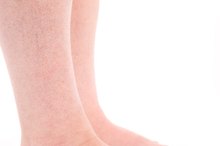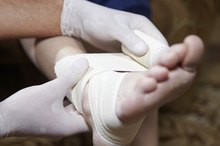Dull Aches in the Shin
A dull ache in your shin is uncomfortable and may prevent you from performing well at work or school and can even keep you awake at night. Leg pain is a common symptom and complaint and can be caused by overuse injuries or a serious disease, according to the National Library of Medicine 1. Fortunately, a dull ache in your shin is usually from strenuous exercise and will go away on its own.
If you are experiencing serious medical symptoms, seek emergency treatment immediately.
Causes
Leg pain can be the result of muscle cramps, injury, blockage of a blood vessel from atherosclerosis or a clot, infection or inflammation. Diseases like cellulitis, arthritis and gout can also cause leg pain. Nerve damage and varicose veins are also common culprits.
Shin Splints
Pain in the Quadriceps
Learn More
Shin splints are an inflammatory reaction involving the connective tissue of the leg. They are the most common cause of exercise-induced leg pain, according to the American Academy of Podiatric Sports Medicine. Dull aches in the shin, commonly known as shin splints, refer to pain around the large tibia bone -- typically referred to as medial tibial stress syndrome. Pain usually occurs after bouts of strenuous exercise or engaging in sports. Medial tibial stress syndrome is common in runners and people who participate in sports with sudden starts and stops, such as basketball or soccer.
- Shin splints are an inflammatory reaction involving the connective tissue of the leg.
- Medial tibial stress syndrome is common in runners and people who participate in sports with sudden starts and stops, such as basketball or soccer.
Treatment and Prevention
Treatment and prevention of dull aches in your shin will depend on the cause of your pain. You can treat shin splints at home with rest, ice, elevation and avoiding weight-bearing activities. Take over-the-counter anti-inflammatory medicine to reduce pain and inflammation. Perform range of motion and gentle stretching exercises to ease discomfort. Gradually return to activity, beginning with low-impact exercises, like swimming. Wear appropriate athletic footwear. If an activity makes your shins ache, stop doing it immediately.
- Treatment and prevention of dull aches in your shin will depend on the cause of your pain.
- If an activity makes your shins ache, stop doing it immediately.
Diagnosis
Unexplained Shooting Pain in My Shins
Learn More
Your doctor can diagnose the cause of the dull aches in your shin. Tell your doctor about any previous injuries and strenuous activities, or if you have any other symptoms like the red skin of cellulitis or the swollen joints of arthritis and gout. Your doctor will ask you if the dull ache is in one shin or both, and how long you have had the pain. She may recommend further testing, such as:
- an arteriogram to check blood flow to your legs
- blood tests
- bone scans or bone biopsies
- MRI
- X-rays if she feels the dull aches in your shin is from something other than an overuse injury like shin splints
- Your doctor can diagnose the cause of the dull aches in your shin.
- Your doctor will ask you if the dull ache is in one shin or both, and how long you have had the pain.
Related Articles
References
- National Library of Medicine: Leg Pain; August 2009
- McClure CJ, Oh R. Medial Tibial Stress Syndrome. [Updated 2019 Apr 4]. In: StatPearls [Internet]. Treasure Island (FL): StatPearls Publishing; 2020 Jan-. Available from: https://www.ncbi.nlm.nih.gov/books/NBK538479/
- McClure CJ, Oh R. Medial Tibial Stress Syndrome. [Updated 2019 Apr 4]. In: StatPearls [Internet]. Treasure Island (FL): StatPearls Publishing; 2020 Jan-.
- Winters M. The diagnosis and management of medial tibial stress syndrome : An evidence update. Diagnostik und Therapie des Schienbeinkantensyndroms : Update zur Studienlage. Unfallchirurg. 2020;123(Suppl 1):15‐19. doi:10.1007/s00113-019-0667-z
- Galbraith RM, Lavallee ME. Medial tibial stress syndrome: conservative treatment options. Curr Rev Musculoskelet Med. 2009;2(3):127‐133. Published 2009 Oct 7. doi:10.1007/s12178-009-9055-6
- Franklyn M, Oakes B. Aetiology and mechanisms of injury in medial tibial stress syndrome: Current and future developments. World J Orthop. 2015;6(8):577‐589. Published 2015 Sep 18. doi:10.5312/wjo.v6.i8.577
- Franklyn M, Oakes B. Aetiology and mechanisms of injury in medial tibial stress syndrome: Current and future developments. World J Orthop. 2015 Sep 18;6(8):577-89. doi: 10.5312/wjo.v6.i8.577
- Bonasia DE, Rosso F, Cottino U, Rossi R. Exercise-induced leg pain. Asia Pac J Sports Med Arthrosc Rehabil Technol. 2015;2(3):73‐84. Published 2015 May 2. doi:10.1016/j.asmart.2015.03.003
- Arnold MJ, Moody AL. Common Running Injuries: Evaluation and Management. Am Fam Physician. 2018 Apr 15;97(8):510-16.
- Rankin A. An Evidence-Based Case Study of Unilateral Shin Splints: Do Red Flags Function in Paediatric Osteosarcoma? Physiother Can. 2015 Fall;67(4):365-68. doi: 10.3138/ptc.2014-79
- Winters M, Eskes M, Weir A, Moen MH, Backx FJ, Bakker EW. Treatment of medial tibial stress syndrome: a systematic review. Sports Med. 2013;43(12):1315‐1333. doi:10.1007/s40279-013-0087-0
- Craig DI. Medial tibial stress syndrome: evidence-based prevention. J Athl Train. 2008;43(3):316‐318. doi:10.4085/1062-6050-43.3.316
Writer Bio
Lynn Hetzler has been a writer since 2000. She was editor in chief and head writer for the online publication Eye on Cameraware. She owns a computer store offering repair, websites, instruction, and more. Hetzler is a certified medical assistant with experience in oncology, laboratory testing and protocol writing.








